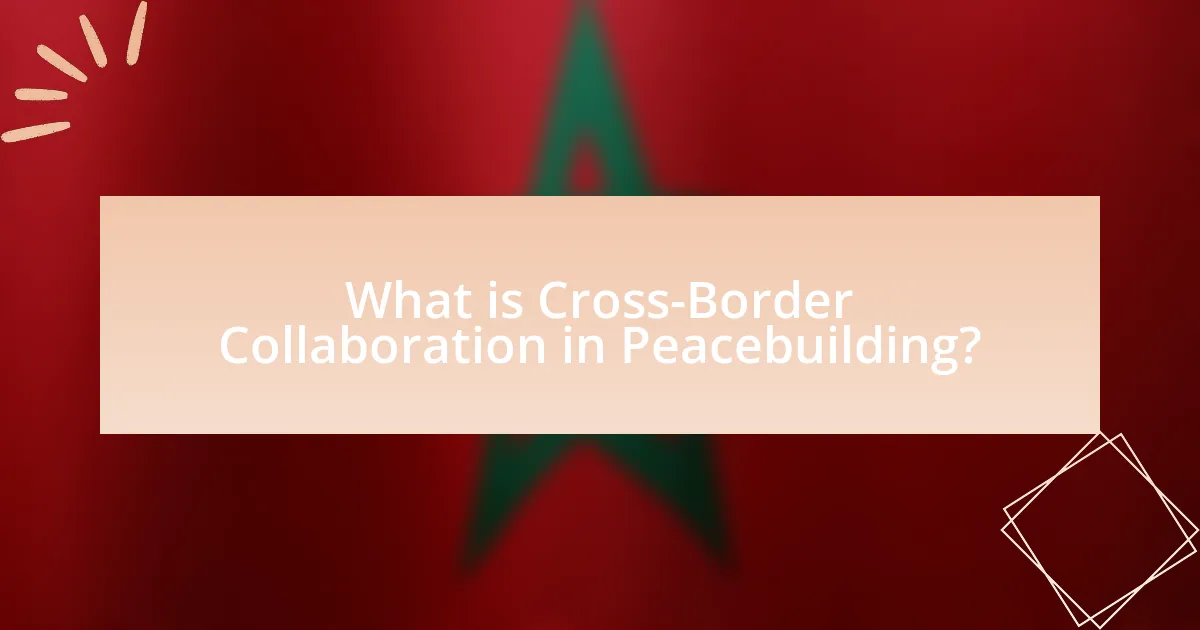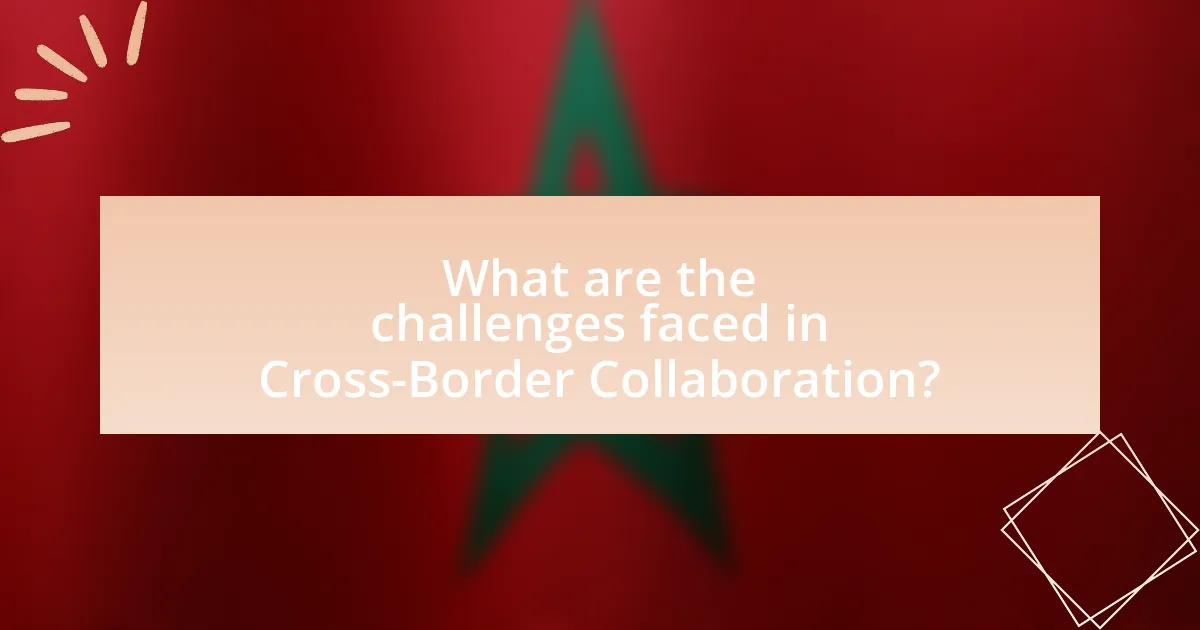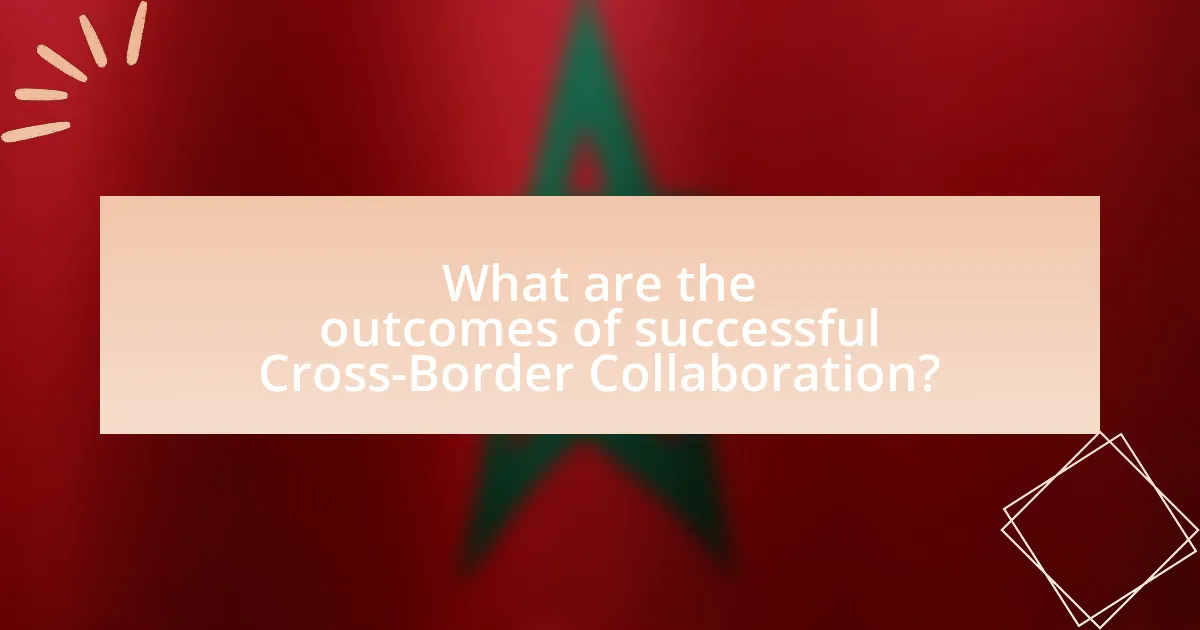Cross-Border Collaboration in Peacebuilding involves cooperative efforts among various stakeholders, including governments, NGOs, and local communities, to address shared challenges such as violence and social injustice across national borders. The article explores how global civil society engages in these collaborations through partnerships and advocacy, emphasizing key principles like mutual respect and effective communication. It also examines the impact of cultural differences, political barriers, and legal frameworks on collaboration, while highlighting successful case studies and best practices that enhance peacebuilding efforts. Ultimately, the article underscores the importance of trust and shared goals in fostering sustainable peace through cross-border initiatives.

What is Cross-Border Collaboration in Peacebuilding?
Cross-Border Collaboration in Peacebuilding refers to cooperative efforts between different countries or regions aimed at fostering peace and resolving conflicts. This collaboration often involves various stakeholders, including governments, non-governmental organizations, and local communities, working together to address shared challenges such as violence, displacement, and social injustice. For instance, initiatives like the European Union’s cross-border cooperation programs have successfully facilitated dialogue and joint projects among neighboring countries to promote stability and reconciliation. Such collaborative efforts are essential in creating sustainable peace, as they leverage diverse perspectives and resources to tackle complex issues that transcend national borders.
How does Global Civil Society engage in Cross-Border Collaboration?
Global Civil Society engages in Cross-Border Collaboration primarily through partnerships, networks, and advocacy efforts that transcend national boundaries. These organizations often form coalitions to address global issues such as human rights, environmental protection, and conflict resolution, leveraging shared resources and expertise. For instance, organizations like Amnesty International and Human Rights Watch collaborate internationally to monitor human rights abuses and mobilize public opinion, demonstrating the effectiveness of cross-border alliances in influencing policy changes. Additionally, platforms such as the Global Fund for Community Foundations facilitate funding and resource sharing among civil society groups across different countries, enhancing their capacity to work together on common goals.
What are the key principles guiding Cross-Border Collaboration?
The key principles guiding Cross-Border Collaboration include mutual respect, shared goals, effective communication, and trust-building. Mutual respect ensures that all parties acknowledge each other’s cultural and contextual differences, fostering an inclusive environment. Shared goals align the efforts of diverse stakeholders towards common objectives, enhancing cooperation. Effective communication facilitates transparency and understanding, which are crucial for addressing challenges that arise during collaboration. Trust-building is essential for sustaining long-term partnerships, as it encourages open dialogue and commitment among collaborators. These principles are supported by successful case studies in international peacebuilding efforts, demonstrating their effectiveness in fostering collaborative relationships across borders.
How do cultural differences impact Cross-Border Collaboration?
Cultural differences significantly impact cross-border collaboration by influencing communication styles, decision-making processes, and conflict resolution approaches. For instance, in cultures that prioritize collectivism, such as many Asian societies, group consensus is often valued over individual opinions, which can lead to slower decision-making in collaborative efforts. Conversely, in individualistic cultures, like those in North America, quick, decisive actions may be preferred, potentially causing friction when working together. Research by Hofstede indicates that cultural dimensions, such as power distance and uncertainty avoidance, shape how teams interact across borders, affecting trust and cooperation levels. These differences can lead to misunderstandings and misalignments in objectives, ultimately hindering effective collaboration.
Why is Cross-Border Collaboration essential for Peacebuilding?
Cross-border collaboration is essential for peacebuilding because it fosters dialogue and cooperation among diverse communities, which is crucial for addressing the root causes of conflict. By engaging multiple stakeholders across borders, such as governments, NGOs, and local populations, collaborative efforts can create shared understanding and trust, reducing tensions and promoting stability. For instance, the United Nations has highlighted that cross-border initiatives, like joint peacekeeping missions and transnational dialogues, have been effective in regions such as the Great Lakes of Africa, where historical grievances and resource disputes have been mitigated through cooperative frameworks. This collaborative approach not only enhances conflict resolution but also builds resilience against future conflicts by integrating various perspectives and resources.
What role does trust play in Cross-Border Collaboration?
Trust is essential in cross-border collaboration as it fosters open communication, mutual understanding, and effective partnerships among diverse stakeholders. In the context of global civil society’s role in peacebuilding, trust enables organizations from different countries to share resources, knowledge, and strategies, which enhances their collective impact. Research indicates that high levels of trust among collaborators lead to increased cooperation and successful conflict resolution, as seen in initiatives like the European Union’s cross-border programs, which have effectively reduced tensions and promoted stability in historically conflict-prone regions.
How does Cross-Border Collaboration address root causes of conflict?
Cross-border collaboration addresses root causes of conflict by fostering dialogue, building trust, and promoting shared interests among communities separated by borders. This collaborative approach enables stakeholders to identify and address underlying issues such as resource scarcity, historical grievances, and socio-economic disparities. For instance, initiatives like the European Union’s cross-border cooperation programs have successfully reduced tensions by facilitating joint economic projects and cultural exchanges, which have been shown to enhance mutual understanding and cooperation. Such evidence demonstrates that when communities work together across borders, they can effectively mitigate the factors that lead to conflict.

What are the challenges faced in Cross-Border Collaboration?
Cross-border collaboration faces several challenges, including cultural differences, legal and regulatory barriers, and communication issues. Cultural differences can lead to misunderstandings and conflicts, as varying norms and values affect collaboration dynamics. Legal and regulatory barriers often complicate the establishment of partnerships, as differing laws can hinder joint initiatives. Communication issues arise from language barriers and varying communication styles, which can impede effective information exchange. These challenges are well-documented in studies such as “Cross-Border Collaboration: Challenges and Opportunities” by the International Journal of Peace Studies, highlighting the complexities involved in fostering successful cross-border partnerships in peacebuilding efforts.
How do political barriers affect Cross-Border Collaboration?
Political barriers significantly hinder cross-border collaboration by creating obstacles such as restrictive regulations, lack of trust, and differing political agendas. These barriers can lead to reduced communication and cooperation between entities in different countries, ultimately impeding joint initiatives aimed at peacebuilding. For instance, the European Union’s Schengen Agreement facilitates cross-border collaboration by minimizing political barriers, while countries with strict border controls, like North Korea, severely limit collaborative efforts. Research indicates that political instability can decrease foreign direct investment by up to 30%, illustrating how political barriers directly impact collaborative opportunities.
What are the implications of differing legal frameworks?
Differing legal frameworks can significantly impact cross-border collaboration in peacebuilding efforts. These variations can lead to inconsistencies in the enforcement of laws, creating challenges for organizations working across jurisdictions. For instance, differing regulations on funding, human rights, and operational mandates can hinder the ability of civil society organizations to effectively coordinate and implement peace initiatives. A study by the United Nations Development Programme highlights that legal disparities can result in increased operational risks and compliance costs, ultimately affecting the sustainability of peacebuilding projects.
How can language and communication barriers hinder collaboration?
Language and communication barriers can significantly hinder collaboration by creating misunderstandings and reducing the effectiveness of information exchange. When individuals or groups do not share a common language or have different communication styles, it can lead to misinterpretations of messages, resulting in confusion and conflict. For instance, a study by the European Commission found that 56% of businesses reported that language barriers negatively impacted their ability to collaborate internationally. This statistic highlights the tangible effects of communication challenges on collaborative efforts, particularly in cross-border contexts where effective dialogue is crucial for peacebuilding initiatives.
What strategies can enhance Cross-Border Collaboration?
To enhance cross-border collaboration, establishing clear communication channels is essential. Effective communication fosters understanding and trust among stakeholders from different countries, which is crucial for successful collaboration. Research indicates that organizations that prioritize transparent communication are more likely to achieve their collaborative goals, as seen in the European Union’s cross-border initiatives that have improved regional cooperation and conflict resolution. Additionally, leveraging technology, such as collaborative platforms and social media, can facilitate real-time interaction and information sharing, further strengthening partnerships across borders.
How can technology facilitate Cross-Border Collaboration?
Technology facilitates cross-border collaboration by providing platforms for real-time communication and information sharing among diverse stakeholders. Tools such as video conferencing, collaborative software, and social media enable organizations and individuals from different countries to connect, share resources, and coordinate efforts efficiently. For instance, the use of platforms like Zoom and Slack has increased the ability of global civil society organizations to work together on peacebuilding initiatives, allowing for immediate feedback and collective problem-solving. According to a report by the United Nations, technology has significantly enhanced the capacity for international cooperation, with 70% of organizations reporting improved collaboration through digital tools.
What role do local communities play in strengthening collaboration?
Local communities play a crucial role in strengthening collaboration by fostering trust and facilitating communication among diverse groups. They serve as the foundational units where relationships are built, enabling stakeholders to engage in dialogue and share resources effectively. Research indicates that local community involvement enhances the legitimacy of collaborative efforts, as seen in peacebuilding initiatives where grassroots participation leads to more sustainable outcomes. For instance, the United Nations Development Programme highlights that local engagement in conflict resolution processes significantly increases the likelihood of lasting peace, demonstrating the effectiveness of community-driven collaboration in cross-border contexts.

What are the outcomes of successful Cross-Border Collaboration?
Successful cross-border collaboration leads to enhanced peacebuilding efforts, increased resource sharing, and strengthened relationships among diverse communities. These outcomes are evidenced by initiatives that have effectively reduced conflict and fostered dialogue, such as the European Union’s cross-border programs, which have facilitated cooperation among member states, resulting in a significant decrease in regional tensions. Additionally, collaborative projects often yield innovative solutions to shared challenges, as seen in various humanitarian efforts where organizations pool expertise and resources to address crises more effectively.
How does Cross-Border Collaboration contribute to sustainable peace?
Cross-border collaboration contributes to sustainable peace by fostering dialogue and cooperation among diverse communities, which reduces tensions and builds trust. This collaborative approach enables stakeholders from different nations to address shared challenges, such as economic disparities and security threats, thereby creating a more stable environment. For instance, initiatives like the European Union have demonstrated that joint economic projects and cultural exchanges can lead to long-term peace by promoting interdependence and mutual understanding among member states.
What are some successful case studies of Cross-Border Collaboration?
Successful case studies of cross-border collaboration include the European Union’s Erasmus Program, which facilitates student exchanges among member states, enhancing educational and cultural ties. Another example is the Great Lakes Region’s Regional Peace and Security Program, which involves multiple countries working together to address conflict and promote stability. Additionally, the United Nations’ Peacebuilding Fund has supported cross-border initiatives in regions like West Africa, fostering cooperation among nations to address shared security challenges. These cases demonstrate effective collaboration leading to improved relations and peacebuilding outcomes.
How can lessons learned from these cases inform future efforts?
Lessons learned from these cases can inform future efforts by providing actionable insights into effective strategies for cross-border collaboration in peacebuilding. For instance, successful initiatives often highlight the importance of inclusive dialogue among diverse stakeholders, which fosters trust and mutual understanding. Evidence from past peacebuilding efforts, such as the Good Friday Agreement in Northern Ireland, demonstrates that involving local communities and civil society organizations leads to more sustainable outcomes. Additionally, analyzing failures, such as the lack of coordination in the Syrian peace talks, underscores the necessity of establishing clear communication channels and shared objectives among international actors. These lessons emphasize that future peacebuilding efforts must prioritize collaboration, inclusivity, and strategic planning to enhance effectiveness and resilience in conflict-affected regions.
What best practices should be adopted for effective Cross-Border Collaboration?
Effective cross-border collaboration requires establishing clear communication channels, fostering mutual trust, and aligning goals among diverse stakeholders. Clear communication ensures that all parties understand objectives and expectations, which is critical in complex international environments. Fostering mutual trust builds relationships that facilitate cooperation, while aligning goals ensures that all stakeholders work towards a common purpose, enhancing the effectiveness of collaborative efforts. Research indicates that successful cross-border initiatives often involve regular meetings and shared platforms for dialogue, which further reinforce these best practices.
How can organizations build trust among diverse stakeholders?
Organizations can build trust among diverse stakeholders by fostering open communication and actively engaging in collaborative decision-making processes. This approach ensures that all voices are heard and valued, which is essential in a multicultural context. Research indicates that organizations that prioritize transparency and inclusivity in their operations are more likely to gain the trust of varied stakeholders. For instance, a study published in the Journal of Business Ethics found that organizations demonstrating ethical practices and stakeholder engagement significantly enhance trust levels among diverse groups. By implementing these strategies, organizations can effectively cultivate a trusting environment conducive to cross-border collaboration in peacebuilding efforts.
What are the key elements of a successful collaborative framework?
The key elements of a successful collaborative framework include clear communication, mutual trust, shared goals, and defined roles. Clear communication ensures that all parties understand objectives and expectations, which is essential for effective collaboration. Mutual trust fosters a safe environment where participants feel valued and are more likely to share ideas and resources. Shared goals align the efforts of diverse stakeholders, creating a unified direction for the collaboration. Defined roles clarify responsibilities, preventing overlap and confusion, which enhances efficiency. These elements are supported by research indicating that successful collaborations in peacebuilding often hinge on these foundational aspects, as highlighted in studies on cross-border initiatives.